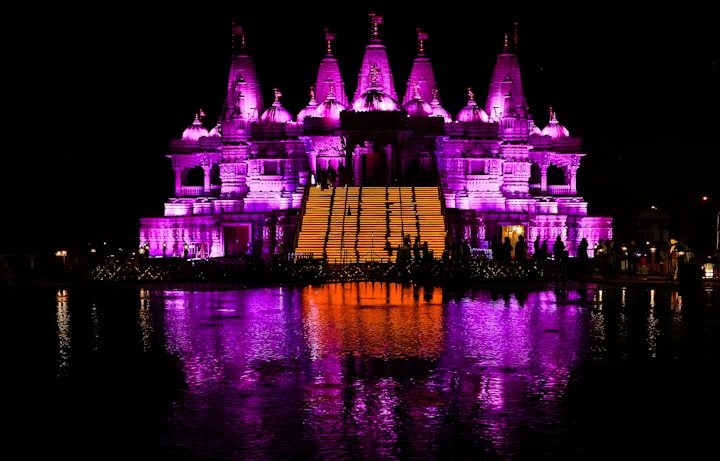"The Triumph of Faith: Building the Ram Mandir"
ram mandir

Once upon a time, in the ancient city of Ayodhya, there stood a piece of land that held the dreams and aspirations of millions. This sacred land was at the heart of a centuries-old dispute, a symbol of religious harmony, and a testament to the resilience of faith. The land was believed to be the birthplace of Lord Ram, a revered figure in Hinduism, and the epicenter of a historical struggle that would eventually lead to the construction of the magnificent Ram Mandir.
The story begins many years ago, in a time when the dispute over the land in Ayodhya had escalated to a national debate. The site was claimed by both Hindus and Muslims, each community holding deep-rooted sentiments and historical narratives associated with it. The dispute had become a socio-political issue, polarizing communities and casting a shadow over the unity of the nation.
As the years passed, attempts were made to find an amicable solution through negotiations, legal battles, and dialogue. However, the issue remained unresolved, and the land continued to be a symbol of division rather than unity. The atmosphere was tense, and people anxiously awaited a resolution that would bring closure to the longstanding dispute.
In the midst of this turmoil, a group of religious leaders from various communities came together with a shared vision of fostering unity and understanding. They believed in the power of dialogue and peaceful coexistence, and they embarked on a journey to find a common ground that would satisfy the sentiments of all parties involved.
After months of deliberation, the leaders proposed a unique solution – a grand temple dedicated to Lord Ram, alongside a mosque in a different location. This suggestion aimed to honor the beliefs of the Hindu community while also addressing the concerns of the Muslim community. It was a bold move that required compromise, understanding, and a collective commitment to building a future based on harmony.
Surprisingly, the proposal gained traction among the people, and a sense of hope began to emerge. The leaders, with the support of the communities they represented, approached the government with their suggestion. The government, recognizing the potential for peace and unity, lent its support to the proposal, and a plan was set in motion to bring the vision to life.
The construction of the Ram Mandir became a symbol of national harmony and cooperation. Hindus, Muslims, and people from various other communities joined hands to work towards a common goal. The construction process was not merely about erecting a physical structure; it was about building bridges between communities, mending historical wounds, and fostering an atmosphere of mutual respect and understanding.
Skilled artisans, architects, and craftsmen from different religious backgrounds came together to create a masterpiece that would stand as a testament to India's rich cultural heritage. The design of the temple incorporated elements that reflected the architectural diversity of the country, showcasing the unity in diversity that had always been at the core of Indian civilization.
As the construction progressed, stories of collaboration and camaraderie emerged from the site. Hindus and Muslims worked side by side, breaking barriers and stereotypes that had persisted for generations. The laborers shared their meals, celebrated festivals together, and forged friendships that transcended religious boundaries. The construction site became a microcosm of the India that the visionaries had hoped to create – a nation where diversity was not a source of division but a strength that bound people together.
The news of this unprecedented collaboration spread far and wide, capturing the attention and admiration of people around the world. International media covered the story, highlighting the unique example that India was setting in resolving religious disputes through dialogue and cooperation. The construction of the Ram Mandir became a symbol of hope, inspiring nations grappling with their own religious and cultural differences.
As the grand structure took shape, it became evident that this was more than just a temple; it was a beacon of peace, a symbol of tolerance, and a tribute to the power of collective action. The temple's architecture told the story of India's journey through the ages, incorporating influences from various dynasties and civilizations that had left their mark on the subcontinent.
The day finally arrived when the Ram Mandir was ready to be unveiled to the world. The atmosphere in Ayodhya was electric with anticipation and excitement. People from all walks of life, belonging to different faiths, gathered to witness the historic moment. The inauguration ceremony was a grand affair, attended by religious leaders, politicians, and dignitaries from across the country.
The leaders who had initiated the dialogue stood together, united in their vision of a harmonious India. As the doors of the temple were opened, a wave of emotion swept through the crowd. The sound of prayers, hymns, and chants filled the air, blending into a melody that echoed the spirit of unity that had brought the temple into existence.
In his inaugural address, one of the leaders spoke about the significance of the moment. He emphasized that the Ram Mandir was not just a place of worship for one community; it was a symbol of India's commitment to inclusivity and mutual respect. He expressed gratitude to all those who had contributed to the construction and reiterated the importance of dialogue in resolving complex issues.
The mosque, built in a different location as part of the agreement, was also inaugurated on the same day. The leaders from the Muslim community, along with representatives from various religious groups, gathered to offer prayers and mark the completion of both structures. The dual inauguration sent a powerful message – that India could overcome its differences and build a future where all communities could coexist in peace.
In the years that followed, the Ram Mandir became a pilgrimage site for millions of devotees from around the world. It stood not only as a place of worship but as a living testament to the power of unity and dialogue. The collaborative spirit that had defined its construction continued to inspire people to look beyond religious and cultural differences, fostering an environment of understanding and acceptance.
The story of the Ram Mandir's construction became a chapter in India's history, reminding future generations that even the most deeply rooted disputes could be resolved through empathy, compromise, and a shared commitment to peace. The once-contested land in Ayodhya had transformed into a symbol of national pride, a place where the triumph of faith was not just about building a temple but about building a nation that celebrated its diversity.





Comments
There are no comments for this story
Be the first to respond and start the conversation.